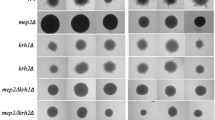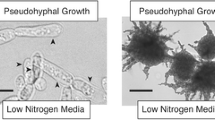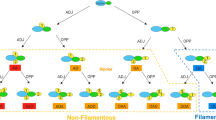Abstract
Background
Diploid cells of Saccharomyces cerevisiae undergo either pseudohyphal differentiation or sporulation in response to depletion of carbon and nitrogen sources. Distinct signaling pathways regulate filamentation and sporulation in response to nutrient limitation. How these pathways are coordinated for implementing distinct cell fate decisions in response to similar nutritional cues is an enigma. Although the role of trehalose pathway in sporulation has been extensively studied, it’s possible role in pseudohyphal differentiation has been unexplored.
Methods and results
Briefly, tps1 and tps2 mutants were tested for their ability to form pseudohyphae independently as well as in the background of GPR1 and RAS2 mutations. Here, we demonstrate that disruption of TPS1 but not TPS2 inhibits pseudohyphae formation. Interestingly, deletion of GPR1 suppresses the above defect. Further genetic analysis revealed that TPS1 and TPS2 exert opposing effects in triggering filamentation.
Conclusion
We provide new insights into the role of an otherwise well-known pathway of trehalose biosynthesis in pseudohyphal differentiation. Based on additional data we propose that downstream signaling, mediated by cAMP may be modulated by nutrient mediated differential regulation of RAS2 by TPS1 and TPS2.





Similar content being viewed by others
References
Gagiano M, Bauer FF, Pretorius IS (2002) The sensing of nutritional status and the relationship to filamentous growth in Saccharomyces cerevisiae. FEMS Yeast Res 2:433–470. https://doi.org/10.1016/S1567-1356(02)00133-2
Gancedo JM (2008) The early steps of glucose signalling in yeast. FEMS Microbiol Rev 32:673–704
Gimeno CJ, Styles CA, Fink GR (1992) Unipolar cell divisions in the yeast S. cerevisiae lead to filamentous growth: regulation by starvation and RAS. Cell 68:1077–1090
Iyer RS, Das M, Bhat PJ (2008) Pseudohyphal differentiation defect due to mutations in GPCR and ammonium signaling is suppressed by low glucose concentration: a possible integrated role for carbon and nitrogen limitation. Curr Gen 54:71–81. https://doi.org/10.1007/s00294-008-0202-1
Lengeler KB, Davidson RC, Souza CD, Harashima T, Shen W, Wang P, Pan X, Waug M, Heitman J (2000) Signal transduction cascades regulating fungal development and virulence. MMBR 64:746–785
Madhani HD (2000) Interplay of intrinsic and extrinsic signals in yeast differentiation. PNAS 97:13461–13463
Cullen PJ, Sprague GF (2012) The regulation of filamentous growth in yeast. Genetics 190:23–49. https://doi.org/10.1534/genetics.111.127456
Honigberg SM, Purnapatre K (2003) Signal pathway integration in the switch from the mitotic cell cycle to meiosis in yeast. J Cell Sci 116:2137–2147. https://doi.org/10.1242/jcs.00460
Jungbluth M, Taxis C (2012) Acetate regulation of spore formation is under the control of the Ras/Cyclic AMP/protein kinase A pathway and carbon dioxide in Saccharomyces cerevisiae. Eukaryot Cell 11:1021–1032. https://doi.org/10.1128/EC.05240-11
Weidberg H, Moretto F, Spedale G, Amon A, van Werven FJ (2016) Nutrient control of yeast gametogenesis is mediated by TORC1, PKA and energy availability. PLoS Genet 12:1–26. https://doi.org/10.1371/journal.pgen.1006075
van De Velde S, Thevelein JM (2008) Cyclic AMP-protein kinase A and Snf1 signaling mechanisms underlie the superior potency of sucrose for induction of filamentation in Saccharomyces cerevisiae. Eukaryot Cell 7:286–293. https://doi.org/10.1128/EC.00276-07
Lorenz MC, Heitman J (1998) The MEP2 ammonium permease regulates pseudohyphal differentiation in Saccharomyces cerevisiae. EMBO J 17:1236–1247. https://doi.org/10.1093/emboj/17.5.1236
Rutherford JC, Chua G, Hughes T, Cardenas ME, Heitman J (2008) A Mep2-dependent transcriptional pofile links permease function to gene expression during pesudohyphal growth in Saccharomyces cerevisiae. Mol Biol Cell 19:3028–3039
Boeckstaens M, André B, Marini AM (2007) The yeast ammonium transport protein Mep2 and its positive regulator, the Npr1 kinase, play an important role in normal and pseudohyphal growth on various nitrogen media through retrieval of excreted ammonium. Mol Microbiol 64:534–546
Boeckstaens M, Llinares E, Van Vooren P, Marini AM (2014) The TORC1 effector kinase Npr1 fine tunes the inherent activity of the Mep2 ammonium transport protein. Nat Comm 5:3101. https://doi.org/10.1038/ncomms4101
Xue Y, Hirsc JP (1998) GPR1 encodes a putative G protein-coupled receptor that associates with the Gpa2p G α subunit and functions in a Ras-independent pathway. EMBO J 17:1996–2007
Santangelo GM (2006) GLucose signaling in Saccharomyces cerevisiae. Microbiol Mol Biol Rev 70:253–282
Harashima T, Heitman J (2005) Gα subunit Gpa2 recruits kelch repeat subunits that inhibit receptor-G protein coupling during cAMP induced dimorphic transitions in Saccharomyces cerevisiae. Mol Biol Cell 16:4557–4571
Iyer RS, Bhat PJ (2017) KRH1 and KRH2 are functionally non-redundant in signaling for pseudohyphal differentiation in Saccharomyces cerevisiae. Curr Gen 63:851–859. https://doi.org/10.1007/s00294-017-0684-9
Rupp S, Summers E, Lo HJ, Madhani H, Fink G (1999) MAP kinase and cAMP filamentation signaling pathways converge on the unusually large promoter of the yeast FLO11 gene. EMBO J 18:1257–1269
Kuchin S, Vyas VK, Carlson M (2002) Snf1 protein kinase and the repressors Nrg1 and Nrg2 regulate FLO11, haploid invasive growth, and diploid pseudohyphal differentiation. Mol Cell Biol 22:3994–4000
Carlson M, Osmond BC, Neigeborn L, Botstein D (1984) A suppressor of SNF1 mutations causes constitutive high-level invertase synthesis in yeast. Genetics 107:19–32
Kuchin S, Vyas VK, Carlson M (2003) Role of the yeast Snf1 protein kinase in invasive growth. Biochem Soc Trans 31:175–177. https://doi.org/10.1042/bst0310175
Apweiler E, Sameith K, Margaritis T, Brabers N, van de Pasch L, Bakker LV, van Leenen D, Holstege FCP, Kemmeren P (2012) Yeast glucose pathways converge on the transcriptional regulation of trehalose biosynthesis. BMC Genomics 13:239
De Silva-Udawatta MN, Cannon JF (2001) Roles of trehalose phosphate synthase in yeast glycogen metabolism and sporulation. Mol Microbiol 40:1345–1356. https://doi.org/10.1046/j.1365-2958.2001.02477.x
Thevelein JM, Hohmann S (1995) Trehalose synthase: guard to the gate of glycolysis in yeast? TIBS 20:3–9
Zaragoza O, Blazquez MA, Gancedo C (1998) Disruption of the Candida albicans TPS1 gene encoding trehalose-6-phosphate synthase impairs formation of hyphae and decreases infectivity. J Bact 180:3809–3815
van Dijck P, De Rop L, Szlufcik K, Van Ael E, Thevelein JM (2002) Disruption of the Candida albicans TPS2 gene encoding trehalose-6-phosphate phosphatase decreases infectivity without affecting hypha formation. Infect Immun 70:1772–1782. https://doi.org/10.1128/IAI.70.4.1772-1782.2002
Maidan MM, De Rop L, Relloso M, Diez-Orejas R, Thevelein JM, Van Dijck P (2008) Combined inactivation of the Candida albicans GPR1 and TPS2 genes results in avirulence in a mouse model for systemic infection. Infect Immun 76:1686–1694. https://doi.org/10.1128/IAI.01497-07
Chary SN, Hicks GR, Yoon GC, Carter D, Raikhel NV (2008) Trehalose-6-phosphate synthase/phosphatase regulates cell shape and plant architecture in arabidopsis. Plant Physiol 146:97–107. https://doi.org/10.1104/pp.107.107441
Adams A, Gottschling DE, Kaiser CA, Stearns T (1997) Methods in yeast genetics cold spring harbor. Cold Spring Harbor Laboratory, New York, pp 1–157
Wach A, Brachat A, Pohlmann R, Philippsen P (1994) New heterologous modules for classical or PCR-based gene disruptions in Saccharomyces cerevisiae. Yeast 10:1793–1808
Lorenz MC, Heitman J (1997) Yeast pseudohyphal growth is regulated by GPA2, a G protein alpha homolog. EMBO J 16:7008–7018. https://doi.org/10.1093/emboj/16.23.7008
Peeters K, Van Leemputte F, Fischer B, Bonini BM, Quezada H, Tsytlonok M, Haesen D, Vanthienen W, Bernardes N, Gonzalez-Blas CB, Janssens V, Tompa P, Versées W, Thevelein JM (2017) Fructose-1,6-bisphosphate couples glycolytic flux to activation of Ras. Nat Commun 8:922. https://doi.org/10.1038/s41467-017-01019-z
Schneider CA, Rasband WS, Eliceiri KW (2012) NIH image to ImageJ: 25 years of image analysis. Nat Methods 9:671–675
van Heerden JH, Wortel MT, Bruggeman FJ, Heijnen JJ, Bollen YJM, Planqué R, Hulshof J, O’Toole TG, Wahl SA, Teusink B (2014) Lost in transition: start-up of glycolysis yields subpopulations of nongrowing cells. Science 343:1245114. https://doi.org/10.1126/science.1245114
Suzuki C, Hori Y, Kashiwagi Y (2003) Screening and characterization of transposon-insertion mutants in a pseudohyphal strain of Saccharomyces cerevisiae. Yeast 20:407–415
Eleutherio E, Panek A, De Mesquita JF, Trevisol E, Magalhães R (2015) Revisiting yeast trehalose metabolism. Curr Gen 61:263–274. https://doi.org/10.1007/s00294-014-0450-1
Lillie SH, Pringle JR (1980) Reserve carbohydrate metabolism in Saccharomyces cerevisiae: responses to nutrient limitation. J Bact 143:1384–1394
Serneels J, Tournu H, DijckP V (2012) Tight control of trehalose content is required for efficient heat-induced cell e.longation in Candida albicans. J Biol Chem 287:36873–36882
Vicente RL, Spina L, Gómez JPL, Dejean S, Parrou JL, François JM (2018) Trehalose-6-phosphate promotes fermentation and glucose repression in Saccharomyces cerevisiae. Microb Cell 5:444–459. https://doi.org/10.15698/mic2018.10.651
Wilson RA, Jenkinson JM, Gibson RP, Littlechild JA, Wang ZY, Talbot NJ (2007) Tps1 regulates the pentose phosphate pathway, nitrogen metabolism and fungal virulence. EMBO J 26:3673–3685
Satoh-Nagasawa N, Nagasawa N, Malcomber S, Sakai H, Jackson D (2006) A trehalose metabolic enzyme controls inflorescence architecture in maize. Nature 11:227–230
Bell W, Klaassen P, Ohnacker M, Boller T, Herweijer M, Schoppink P, Van der zee P, Wiemken A (1992) Characterization of the 56-kDa subunit of yeast trehalose-6-phosphate synthase and cloning of its gene reveal its identity with the product of CIF1, a regulator of carbon catabolite inactivation. Eur J Biochem 209:951–959
Deroover S, Ghillebert R, Broeckx T, Winderickx J, Rolland F (2016) Trehalose-6-phosphate synthesis controls yeast gluconeogenesis downstream and independent of SNF1. FEMS Yeast Res 16:1–15. https://doi.org/10.1093/femsyr/fow036
Se Virgilio C, Burckert N, Bell W, Jeno P, Boller T, Wiemken A (1993) Disruption of TPS2, the gene encoding the 100-kDa subunit of the trehalose-6-phosphate synthase/phosphatase complex in Saccharomyces cerevisiae, causes accumulation of trehalose-6-phosphate and loss of trehalose-6-phosphate phosphatase activity. Eur J Biochem 212:315–323
Gibney PA, Schieler A, Chen JC, Rabinowitz JD, Botstein D (2015) Characterizing the in vivo role of trehalosein Saccharomyces cerevisiae using the AGT1 transporter. PNAS 112:6116–6121
Tomova AA, Kujumdzieva AV, Petrova VY (2019) Carbon source influences Saccharomyces cerevisiae yeast cell survival strategies: quiescence or sporulation. Biotechnol Biotechnol Equip 33:1464–1470. https://doi.org/10.1080/13102818.2019.1674188
Kubler E, Mosch HU, Rupp S, Lisanti MP (1997) Gpa2p, a G-protein α-subunit, regulates growth and pseudohyphal development in Saccharomyces cerevisiae via a cAMP-dependent mechanism. J Biol Chem 272:20321–20323
Mosch HU, Kubler E, Krappman S, Fink GR, Braus GH (1999) Crosstalk between the Ras2p-controlled mitogen activated protein kinase and cAMP pathways during invasive growth of Saccharomyces cerevisiae. Mol Biol Cell 10:1325–1335
Ryan O, Shapiro RS, Kurat CF et al (2012) Global gene deletion analysis exploring yeast filamentous growth. Science 337:1353–1356
Lorenz MC, Pan X, Harashima T, Cardenas ME, Xue Y, Hirsch JP, Heitman J (2000) The G protein-coupled receptor Gpr1 is a nutrient sensor that regulates pseudohyphal differentiation in Saccharomyces cerevisiae. Genetics 154:609–622
Acknowledgements
This work was supported by funding awarded to Dr. Revathi Iyer, by the Department of Science and Technology, India, under the DST WOS-A scheme (SR/WOS-A/LS-58/2017). We thank Prof. R. Patkar, for graciously permitting the use of his laboratory facilities to study the effect of cAMP on the the ras2 mutant.
Funding
This work was supported by funding awarded to Dr. Revathi Iyer, by the Department of Science and Technology, India, under the DST WOS-A scheme (Grant No. SR/WOS-A/LS-58/2017).
Author information
Authors and Affiliations
Contributions
Both authors contributed to the study conception and design. Material preparation, data collection and analysis were performed by Dr. RI. The first draft of the manuscript was written by Dr. RI. Both authors read and approved the final manuscript.
Corresponding author
Ethics declarations
Conflict of interest
The authors have no relevant financial or non-financial interests to disclose.
Ethical approval
This article does not contain any studies with human participants or animals performed by any of the authors.
Additional information
Publisher's Note
Springer Nature remains neutral with regard to jurisdictional claims in published maps and institutional affiliations.
Supplementary Information
Below is the link to the electronic supplementary material.
Rights and permissions
Springer Nature or its licensor holds exclusive rights to this article under a publishing agreement with the author(s) or other rightsholder(s); author self-archiving of the accepted manuscript version of this article is solely governed by the terms of such publishing agreement and applicable law.
About this article
Cite this article
Iyer, R., Bhat, P.J. Trehalose biosynthetic pathway regulates filamentation response in Saccharomyces cerevisiae. Mol Biol Rep 49, 9387–9396 (2022). https://doi.org/10.1007/s11033-022-07792-5
Received:
Accepted:
Published:
Issue Date:
DOI: https://doi.org/10.1007/s11033-022-07792-5




